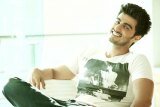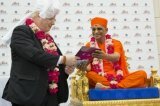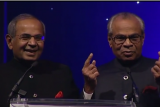Bhagwad Gita - holistic approach to salvation
More like this
It is customary too for the proponents of each of these paths to cite verses after verses from Gita to substantiate and establish their exclusive claim on Bhagwad Gita. Maybe they are all beneficial in either kindling or quenching our intellectual thirst. But we might do well to pass over this issue about “Which of the paths?”, simply because it is futile. Futile because choice is not ours. Choice is solely determined by one’s aptitude & inclinations - inhered Rajasic or Satvic gunas. The Kshetra or Field , which is this body-mind-intellect complex constituted of Satvic, Rajasic & Tamasicgunas in varying degrees, determines the path a seeker is drawn towards and one has little choice over the path.
“All born of Prakriti imbibed with Gunas are helpless”
Through the length of Gita, from beginning till end what we find being emphasized repeatedly and exhaustively is “Chitta Shuddhi”, or what we would like to collectively classify as the “Preparatory perfections”, viz:
- Total faith in the concept of God-principle and scriptures.
- Inquiry about the nature of Self and non-self.
- Intellectual conviction that “Self in me is the Self in all”.
- Non-attachment to sense-objects
- Self-control of senses
- Self-restraint of mind
- Withdrawal from mundane.
- Ego-less, desire-less, firm and tranquil mind, free of anger, envy, lust and greed.
- Even-minded , Equanimity.
The features of the three paths are:
- Karma Marg – focusing on actions only without attachment to fruits of actions.
- Bhakthi Marg – Unswerving devotion and unconditional surrender to God.
- Jyana Marg – Hearing, contemplating and meditating on unity of Self and Brahman (Aham Brahmasmi).
It is self-evident from the features of this path that treading on any of the paths is duplicity and useless in the absence of cultivating these “preparatory perfections”
The milestones of the paths are the same; Goal also is same; Only the aspirants are of different mettle and capability, according to preponderance of Satvic or Rajasic Guna. Some seekers have implicit faith in scriptural injunctions and prohibitions and propitiate their deities by offerings, sacrifice, oblations, austerities, rituals, etc. as prescribed in scriptures. Some seekers have implicit faith in the concept of personal God and they devotedly worship by praising, glorifying and offering their service to God. Some seekers worship by surrendering all fruits of their actions at the feet of their personal God. Some worship by surrendering and submitting themselves to the will of God. Some place themselves and their lifetime for the service of God. Some retire to a forest or a mountain abdicating their worldly contacts and meditate on Brahman. Some others seeing Self in all beings serve mankind with unrequited love, compassion and kindliness. There are yet others who live their lifetime always meditating on Brahman performing only their obligatory duties without expectation of return of good. Man is a multi-dimensional being. A heart swelling up with devotion to the Lord or intellect anchored firmly with conviction upon Brahman or bodily dedication, both in spirit and form, to the worship/service of God and humanity - all leads to the same destination.
Most part of Bhagwad Gita is about these pre-requisites for salvation. The Lord’s elaborate instructions about the nature of three gunas and how these are inter-connected with nature of food-habits, austerities and offerings clearly point to the necessity for a holistic approach for salvation by an earnest seeker. This , I think, is the central message of Lord’s divine dialogue. The Lord's brilliant exposition of the various paths to liberation, his repeated emphasis on the preparatory perfections for salvation, his instructions on the physiological conditioning even to the extent of food habits, speech and conduct; such comprehensive prescription even in the backdrop of his specific commendation of Path of Action to Arjuna - all of which justifies our conclusion that Gita's message is not merely addressed to Arjuna but meant for humanity for all time to come and that holistic approach to salvation is the central message of Bhagwad Gita.
N Balasubramanian is an old time honours graduate in economics and has vast experience and expertise in human relations and resources development. A devotee of Sage of Kanchi - Maha Swamigal, N Balasubramanian is living a quiet and meditative life based upon the Guru's teachings. An avid reader of philosophy in his younger years, he wholly devotes his energies presently, in discovering insights and practical wisdom from ancient Indian scriptures. Based upon his understanding of Acharya's discourses and writings on spirituality, N. Balasubramanian shares these thoughts on IndiaNewsBulletin.com to just provoke your thoughts and kindle your interest in spirituality and philosophy.
Most read
- 2015: Full list of Indian States, capitals and their Chief Ministers
- Indian cabinet 2014: Full list of Ministers and their portfolios in the Modi government
- South Indian actress Trisha Krishnan’s father passes away
- Recipe: Misal Pav – how to make missal masala, usal and tarri
- Review: Southall Travel (Also Travel Trolley and Fly Sharp)
- Ileana D’Cruz and Virat Kohli sizzle in TV ad for Clear anti-dandruff shampoo
- Review: VFS Global Joint Visa Application Centre in Paddington
- FCNR rates comparison
- Commonwealth Games 2014: Full list of Indian gold, silver and bronze medal winners
- Pics: Deepika Padukone and Irrfan Khan’s blossoming chemistry in Piku
India News Bulletin by email
Desi Events
Featured Stories
More Lead Stories
- Review: Southall Travel (Also Travel Trolley and Fly Sharp)
- Mahatma Gandhi statue erected in London’s Parliament Square
- Pics: Deepika Padukone and Irrfan Khan’s blossoming chemistry in Piku
- Pics: Priyanka Chopra and Freida Pinto back the ‘Girl Rising’ campaign in India
- Tamannaah sizzles at Audi Ritz Icon Awards 2014






















